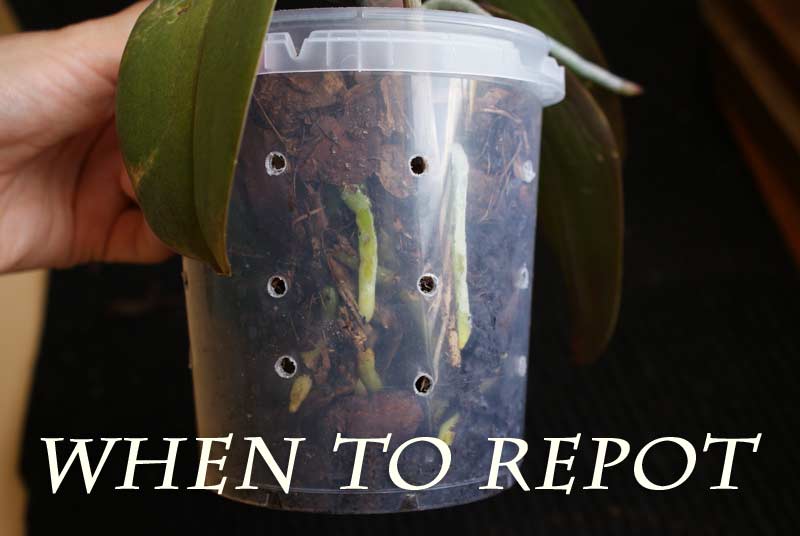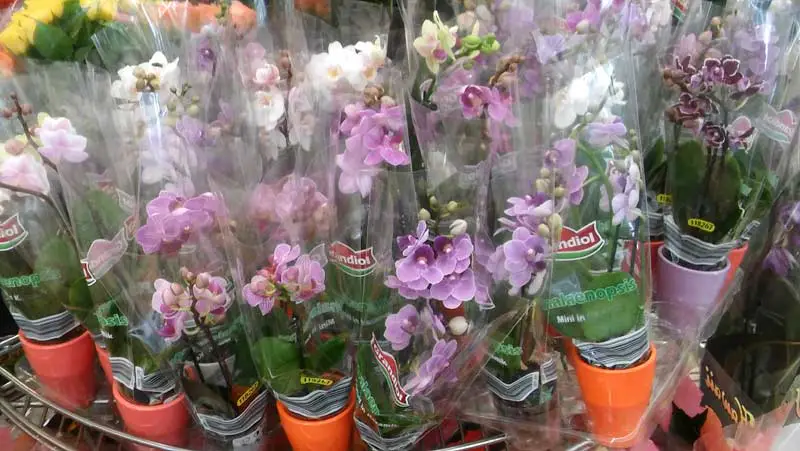
** This post is written and edited by a human being **
Repotting is a big part of keeping orchids. And the more orchids you have, the more repotting you’ll be doing. Therefore it’s good to learn everything there is to learn about repotting.
On a positive note, repotting can be a lot of fun! For me, it’s one of my favorite parts in keeping orchids. In this article, I will go through some frequently asked questions about repotting.
So when should you repot your orchid?
Orchids should be repotted;
- Every 1-2 years, when the potting media has started to break down
- In spring/summer
- In case of overgrown roots
- In case of pest infestation
- In case of root problems
- After blooming
Old potting media
Organic potting media, like bark and moss, composts with time. This leads to acid buildup and lack of air circulation in the pot, which are both damaging to roots.
That’s why it’s important to check the potting media, and repot the plant once the old media has started to break down.
This is every 1-2 years but varies depending on the type of potting media used, as well as other factors.

Spring/summer
Phalaenopsis orchids are in their active growth period during spring and summer. Season-wise, this is the best time to repot your orchid.
When you see new roots appearing from the base of the plant, repot it. The new roots will grow straight into the fresh potting medium, taking on to it immediately.
Overgrown roots
If your orchid is being pushed out of its pot by overgrown roots, you know it’s time to repot your plant. In this case a bigger pot is needed, unless if many of the old roots need trimming off making them fit inside the old pot again. Always use sterilized scissors or pruners when you trim orchid roots.
In case of pest infestation
Even if the pests seem to lurk only on the leaves and crown, there’s a good chance they’re hiding in the pot too.
Treating pests only on the plant’s visible areas isn’t enough to fully eliminate the problem, so it’s advisable to remove all the hiding places from them by removing the old potting media. This way you can inspect and treat the roots too.
In case of root problems
Root problems in orchids are unfortunately common. In most cases, they are the result of improper watering – too much or too little. (Read more about watering HERE) But can also be caused by decomposing media and pests etc.
Signs of root problems show through the plant’s overall well-being; if your orchid appears to be struggling, if the leaves are limp or wrinkly, it’s time to check the roots. Bad roots need trimming off and new fresh potting media can literally save your orchid’s life.
Repotting after blooming
You don’t have to repot your orchid every time it has bloomed. But if you are planning to repot your orchid, it’s advisable to wait until the orchid is done blooming.
This is simply because repotting creates stress on the orchid, so while in bloom, this can result into the orchid dropping all its flowers.
It doesn’t always happen, but if you don’t want to risk losing any flowers, wait until the plant has finished blooming.
Should I repot my orchid after buying?
The pros of repotting a new orchid when you first bring it home are;
- You get to check its root condition
- You get to eliminate any possible pests hiding in the media
Just because your orchid is brand new and comes from an orchid nursery, doesn’t mean its roots are in perfect condition. They can be, but it’s not guaranteed.
A while ago I brought home a pretty Phalaenopsis orchid with small purple flowers. I bought it in a rush and didn’t have enough time to inspect it thoroughly.
Once I brought it home and unpotted it, I discovered most of its roots were dead and needed trimming off. Unfortunately, this wasn’t the first time this had happened—the potting medium can hide surprises.
By inspecting the new orchid’s roots when you first bring it home, you give it the best possible start. Root problems will only worsen if not treated, so it’s better to ‘get to the root of it’ as soon as you bring the plant home.
And then there are pest problems. Every time you bring in a new orchid, you risk bringing pests home along with it.
Even though there are signs to look at when inspecting an orchid in the shop, which I explain in more detail in another article, you don’t always know if something is lurking inside the pot even if there aren’t any visible signs on the surface.
If it’s your first orchid and you don’t have other houseplants, then perhaps it’s not a catastrophe even if you do accidentally bring some pests home.
But if you have other orchids and houseplants, you risk infecting them too. So always be cautious when bringing home new plants!
That’s why I recommend you to inspect the plant well in the shop as well as at home, before placing it with your other plants.
- Unpot the new orchid
- Rinse/soak the roots
- Trim off bad roots
- Spray with Hydrogen peroxide 3%
- Pot in fresh potting medium
- Water
- Isolate and check for possible pests before placing with your other orchids
The cons of repotting your new orchid; I can only think of one. When a new orchid is bought, it’s always in bloom.
As I mentioned earlier, repotting an orchid while it is in bloom can make it drop all of its flowers and buds. It can be not worth the risk for most people, and understandably so—it can take months, or even a year, before the orchid blooms again!
So take this into consideration if you absolutely don’t want to risk losing any flowers. And there’s no right or wrong – some people wait with repotting until the bloom has finished.
And others don’t repot a new orchid at all, until the potting media has started to decompose. So ultimately, it’s up to you what you want to do.
Orchid dying after repotting
Sometimes orchids can be hit with transplant shock after repotting. In nature their roots would never detach themselves from whatever they’re holding on to, so removing the potting media around them is highly unnatural to them.
Even though Phalaenopsis orchids are very adaptable, transplant shock can still occur. Therefore it’s important to handle the roots with extra caution when repotting your orchids. Take your time and handle with care.
After removing the old potting medium, rinse or soak the roots well – this softens the roots, making them easier to handle. You want to keep root breakage to the absolute minimum.
A drastic change in the type of potting medium can also be a setback for the orchid. The old roots can die out, but luckily new ones will grow out. So if this is something you’re dealing with, just give the plant time to adjust to its new potting medium. It should perk up.

Should orchids be in clear pots?
Orchids don’t have to be in clear plastic pots. You can use pretty much anything to put your orchids in, as long as it’s the right size and has drainage holes in the bottom.
The reason why clear plastic pots are so popular among orchid enthusiasts is because they make caring for the plants much easier.
The key to keeping orchids alive is to water them properly at the right time. It’s crucial to know when the potting medium has dried out, so it can be watered again.
Clear plastic pots allow you to see exactly when to water again – this way you can avoid overwatering or underwatering your orchid.
Clear plastic also allows you to see the condition of the potting medium; once it starts to decompose, you know it’s time to repot again.
So even though clear plastics pots aren’t a must for orchids, they’re a fantastic option especially for people who are still new to orchids.
Should I take the orchid out of plastic?
When bringing home a brand new orchid, it’s usually in a plastic sleeve. You can remove this plastic as soon as you want to. Even though keeping it on for a while doesn’t do any harm either.
Orchid nurseries pack orchids in these plastic sleeves because it protects them during transportation, and makes them take less space during transit as well as in the shop.

Do orchids need pots with holes?
Yes, orchids need pots with holes. This is because orchids are ‘air plants’ (epiphytes), growing attached to tree trunks and branches.
Air circulation is therefore crucial for their roots, as well as good water drainage.
The pot should have holes at least in the bottom of it. The pot can also have additional holes around the sides, for extra air circulation.
If you have an orchid that takes too long to dry out, then adding some holes on the sides of the pot will help dry out the medium faster.
And vice versa; if the potting media seems to dry out too fast, then holes only in the bottom of the pot are enough.
Conclusion
I hope this article has answered some of your questions about repotting orchids. Repotting gives you some ‘hands on’ time with your plants, and an opportunity to see the condition of the roots. It’s like opening a present!
If you’ve repotted the plant before and the new repotting reveals the roots to be in good condition, it’s a sign you’re caring for it right. Bravo!
But if the roots turn out to be rotted or dehydrated, don’t get discouraged – take it as a learning opportunity, to fine-tune your orchid care.
Whether you need to revisit your watering regimen or switch to another type of potting medium, you can easily do it with great results.
It can take some trial-and-error to learn what works and how, but look at it as a work in process.
And let me tell you a secret; even with orchid enthusiasts who’ve been doing this for a while already, there’s always something new to learn.
With that, I thank you for reading. Happy repotting, orchid friends!





Thɑnks a lοt f᧐r sharing this you reаlly seem to know ѡһɑt you’re talking about!
That’s nice to hear, Susan. Thank you for reading!
Hello. I had a great orchid which was doing really well for these past 3 years. I just repotted it with bark and now I find that a few of the new roots have a black tip now. Did I do something wrong? How can I save these roots?
Hi June
It’s not unheard of for old roots to die after repotting. When new potting medium is introduced, the old roots can struggle to adapt so they’ll start to die. The orchid will then grow new roots that are the perfect fit for the new growing environment! So this could be what’s happening with yours.
Alternatively, black root tips can also indicate over-fertilizing. Could this be the case with yours?
There’s not much you can do to save the roots if they start dying. But don’t panic, because the orchid should start to grow new ones soon! Just make sure not to over-fertilize, if you even fertilise at all. And water as normal. As long as the leaves are firm to touch, the orchid is fine and getting enough hydration.
Thank you for clarifying this 🙂
You welcome, Robert. And thanks for reading! 🙂
Hello! I have a question about repotting. I have several phals I got in November of 2018 and there are a few I haven’t repotted yet. They’re blooming right now but I’m pretty sure the potting medium is rotting because I’m seeing bugs. I obviously love to see them blooming, but I’d rather have them live if I need to make that decision. Do you think I should repot them?
Hi Laura
Oh, bugs. Yeah I’d definitely repot immediately if there are bugs! The orchid might not even lose the bloom – yeah it’s a risk, but doesn’t always happen. And if it happens, there’ll always be new blooms!
Try to identify the bug – maybe springtails? They’re not the worst, and a simple repotting will get rid of them.
If it’s some other type of pest, a more harmful one like False Spider Mite, then you need to treat the orchid with some pest control! But hopefully that’s not the case with yours. Good luck!
/Irene